Abstract
The end of the 20th century brought about drastic changes in the tropospheric ozone (O3) around the globe. It is, therefore, highly important to gain insight into O3 formation mechanisms and their key precursors in order to assist policymaking to combat O3 pollution. This article synthesizes a bibliometric analysis of O3 formation sensitivity from 1965 to 2022, reported in English language journals available in the Web of Science Core Collection. This study shows that constant expansion in the number of publications has occurred since 2008, with the highest number occurring in 2021. Most publications are from the United States of America (USA), with 406 papers (42.7%), followed by China with 128 papers (13.5%), and the United Kingdom (UK) with 87 papers (9.1%). Citation burst analysis and significant and highly cited research work analysis are used to discover and assess evolving research tendencies. The thematic evolution of author-supplied keywords indicates that the terms “volatile organic compounds” and “ozone precursors” have recently emerged with a higher frequency. This suggests that there is a growing trend in research focused on these topics in the future. The objective of this study is to provide research primacies and future prospects for better analysis of O3 sensitivity, thereby helping to manage O3 pollution.
1. Introduction
Tropospheric ozone (O3) is a harmful, invisible gas present in the atmosphere. This pollutant has detrimental effects on ecosystems and human health. It irritates the nose and eyes and causes respiratory problems [1,2,3,4,5]. Crop yield losses due to prolonged exposure to O3 have been reported [6]. During the 1950s, it was discovered that O3 is produced secondarily by the photochemical reactions of anthropogenic emissions of volatile organic compounds (VOCs) and nitrogen oxides (NOx = NO + NO2) [7].
O3 formation from VOCs and NOx precursors occurs in a non-linear manner in the presence of sunlight [8,9,10]. NOx concentration can increase O3 formation, and, in other cases, VOCs can enhance O3 formation [11,12,13]. Tropospheric O3 formation is a complex process that depends on precursor species and several other factors. The COVID-19 pandemic and subsequent lockdown measures resulted in emission reductions of VOCs and NOx, but O3 concentrations still increased in many regions [14,15,16]. Recent studies suggest this is due to the various factors (e.g., aerosols, meteorology and pollution source distribution) that govern atmospheric O3 formation [12,17].
O3 formation in the atmosphere occurs in one of three ways: (a) VOC-limited; (b) NOx-limited; and (c) transition regimes. In the VOC-limited regime, O3 production relies primarily on VOC levels, whereas in the NOx-limited regime, O3 formation depends on NOX concentrations [18,19]. Insufficient precursor emission reductions can lead to enhanced tropospheric O3 production. Therefore, accurately identifying O3 sensitivity regions is necessary to cultivate effective control strategies to combat O3 pollution. The situation is more complex in China, particularly as the ozone concentration has not shown a reduction in its level since the implementation of China’s National Air pollution prevention plan in 2013. This is due to the production of O3 via complex heterogeneous processes [15,20,21].
Given the complex relationship between O3 precursors and O3 formation sensitivity, we provide a comprehensive overview of the current research trends of O3 precursors and their formation sensitivity. A bibliometric on ozone formation sensitivity from 1965 to 2022 is presented to elucidate the patterns of research and offer perspective into the present advancement and forthcoming paradigm of research. Rapid developments in scientific research result in the increased importance of bibliometric analysis. This sort of investigation is exceptional, as it offers classified information on various aspects of a scientific discipline, including publications, keywords, citations, and collaborations. This study utilizes distinct methods compared to previous research on ozone formation sensitivity. These methodologies enable the construction of a comprehensive research framework and facilitate the identification, organization, and analysis of the principal elements within the topic. To the best of the authors’ knowledge, this is the first bibliometric study on ozone formation sensitivity and its precursors. Thus, the objective is to study recent global research trends and present content and citation analyses in order to recognize the leading studies in this domain. Furthermore, this study examined a wide range of research topics and analyzed the current emerging trends to identify potential valuable directions for further research.
2. Materials and Methods
This section describes the data collection methods used in this bibliometric study of ozone formation sensitivity. Scientific literature can be systematically analysed using bibliometric techniques, retrieving data from online databases such as the Web of Science Core Collection (WoSCC) [22]. We have compiled a comprehensive list of keywords related to ozone formation sensitivity research to ensure maximum precision and recall. A query for WoSCC was formulated by connecting the keywords using Boolean operators. Specifically, the following query was used:
TS = (“ozone formation regimes” OR “ozone formation sensitivity” OR “O3-NOX-VOCs Sensitivity” OR “ozone precursor*”)
The search was performed through the ‘Topic Field’, which considers the ‘Title’, ‘Abstract’ and ‘Keywords Plus®’ of a record. “TS” stands for topic and restricts the search to the articles’ title, abstract, and keywords and “OR” is a boolean operator that connects the various terms in the query. The initial query returned 972 documents. We examined the results from the publication of the first article to the date of the data retrieval (20 November 2022) to obtain a comprehensive, up-to-date understanding of the subject. We narrowed the search to 952 documents by restricting the document types to articles, proceeding papers, and review articles. We downloaded the bibliographic data and imported it into EndNote to ensure there were no duplicate titles, authors, or years. One duplicate document was found and removed. An outline of the bibliometric study road map is shown in Figure 1. Finally, all the screened documents were examined carefully for their contribution to ozone formation sensitivity. The study used MS Excel, MS Access, Power BI, an online visualization platform (https://flourish.studio/ accessed on 20 March 2022), BiblioAnalytics, Citespace, VOSviewer software (version 1.6.15), and Biblioshiny software for the analysis [23].
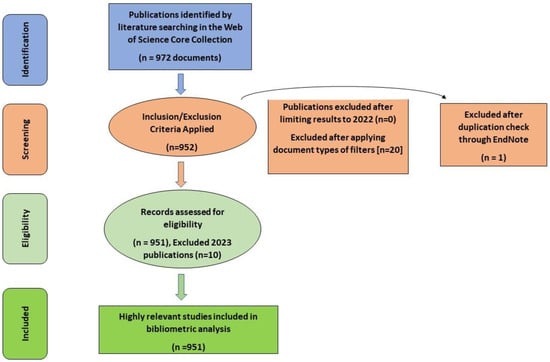
Figure 1.
Flow chart of the steps of the study.
The analysis of bibliographic data is critical to identifying scientific research trends. The bibliometric analysis provides a quantitative means of evaluating scientific research and its impact by identifying the most influential authors and publications and finding research hotspots by analysing publication patterns and citation networks [24]. We systematically examine the existing literature on ozone formation sensitivity using bibliometric techniques. By identifying key research themes, we provide insights for future research directions.
3. Results
3.1. Temporal Analysis of Articles and Their Types
Scientific literature is usually evaluated on the basis of the number of publications and citations. The publication and citation trend can demonstrate the link between lifespan and citation per publication [22,25,26]. Figure 2 illustrates the growth in total publications (TP) and total citations (TC). The data show that the first research publication relating to ozone formation sensitivity was in 1965. The analysis shows little to no increase in publications in the early years, with only single-digit numbers and many years without any publications. Double-digit numbers appear between 1995 and 2008. After 2008, consistent publication growth was observed, with the highest number of publications occurring in 2021 (followed by 2020, 2012, and 2013). The results indicate that research into O3 pollution gained attention relatively lately. This is due to the development of observation methods, including satellite and ground-based systems, over the past two decades, resulting in a vast range of continuous data with wide area coverage and high precision. The number of citations dropped after 2017 and the reasons for citations dropping after 2017 could be explored further.
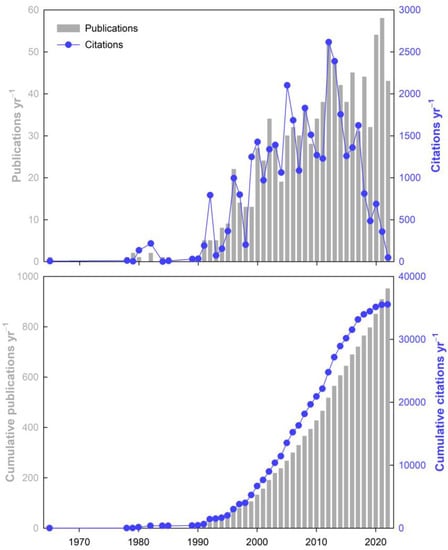
Figure 2.
Yearly growth in ozone formation sensitivity research in terms of publications and citations.
The preferred document type for researchers working on ozone formation sensitivity is “article” with 876 TP, distantly followed by “proceedings paper” with 43 TP, and “review” with 32 TP. “Articles” also have the highest number of citations (29,274 TC), followed by “reviews” (4801 TC) and “proceedings papers” (1468 TC). The document type “review” has more impact (150 TC/TP) than “articles” (33.42 TC/TP) and “proceedings papers” (34.14 TC/TP).
3.2. Authorship Patterns and Most Prolific Scholars in Ozone Formation Sensitivity
Figure 3 shows the authorship patterns in ozone formation sensitivity research ranging from 1 to 41. The data analysis shows a collaborative research trend in this field of study. This analysis reveals the domination of two-author patterns with 139 publications, followed by five and four-author patterns with 136 and 132 publications, respectively. The citation analysis ranks four-author publications top, with 5042 citations, followed by six-author reports, with 4717 citations. Two-author papers have 4426 citations.
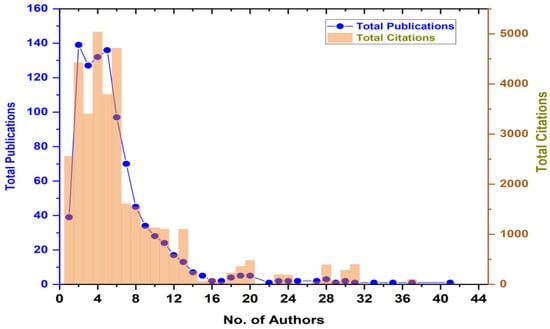
Figure 3.
Authorship patterns in ozone formation sensitivity research in terms of publications and citations.
Table 1 gives the top 20 most prolific researchers in ozone formation sensitivity research. The data shows a trend for collaborative research among the most productive authors, as all authors among the top 20, except one (Shindell DT) published research which was the result of a joint effort. The most productive author, Wang JL, published five pieces of research on the topic as the first author. The second, Collins WJ, published five documents as the first author and 12 in other author categories. The third, Horowitz LW, maintained that position by contributing all publications in other author categories. The citation analysis ranks Shindell DT in the top position with the most citations, followed by Faluvegi G and Collins WJ.

Table 1.
Top 20 most prolific authors.
3.3. Most Productive Journals and Publishers
Identifying the distribution of journals is a crucial component of bibliometric analysis. This information is valuable for guiding future researchers in determining where to concentrate their efforts for finding literature and publishing their work. The top 20 most productive journals publishing on O3 formation sensitivity are listed in Table 2. According to the analysis, Atmospheric Environment is ranked top for total publications (TP) with 169 and cited papers (CP) with 164. Atmospheric Chemistry and Physics, and the Journal of Geophysical Research-Atmospheres, take joint second place with a TP count of 100. The highest number of total citations are also from Atmospheric Environment, followed by the Journal of Geophysical Research-Atmospheres, and Atmospheric Chemistry and Physics. Geoscientific Model Development appears in 12th place; however, its impact (TC/TP) is the highest, followed by Environmental Science & Technology and Science of the Total Environment”.

Table 2.
Most productive journals.
The top publishers on the subject of O3 formation are listed in Table 3, with Elsevier being on top, followed by the Amer geophysical union and Copernicus gesellschaft mbh. As well as the highest number of publications, Elsevier also has the highest number of citations, followed by Amer geophysical union and Copernicus gesellschaft mbh. The Nature Publishing Group has the highest impact (TC/TP), despite comparatively few publications, followed by Wiley-Blackwell and the Natl Acad Sciences.

Table 3.
Most productive publishers.
3.4. Countries and Organizational Productivity
Based on the author’s affiliations, the regional research output on the subject of O3 formation regime is presented. It is important to mention here that the number of publications in a particular area of interest is representative of the significance of that specific region for the subject. Figure 4 illustrates the contribution to research on the topic on a continental basis. Europe has the most publications (contributions from 29 countries), followed by North America (two countries) and Asia (23 countries). Europe also has the highest number of citations, followed by North America and Asia.
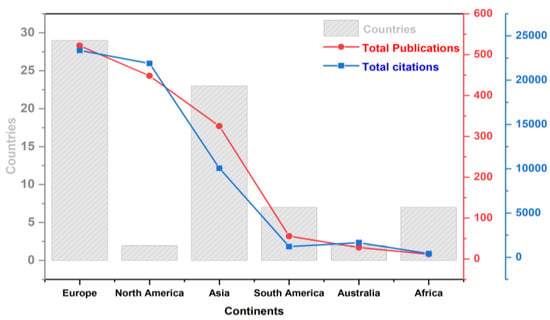
Figure 4.
Most productive continents with number of countries and productivity (Publications and citations).
Figure 5 shows the most productive countries. The USA appears on top with 406 publications, followed by China (128) and the UK (87). The USA also has the highest number of citations. The UK, however, published the third-highest number of documents but is in second place for citations. Articles are regarded as publications from the United Kingdom (UK) if they are from Ireland, England, Scotland, Northern Ireland, and Wales. These countries are also among the most impactful in terms of the emission of gases and have greater resources to study the corresponding air pollution problems. There is greater mitigation concern for O3, compared to other air pollutants, due to its complex non-linear photochemistry, especially in China [9]. Therefore, researchers in these countries have recently started working on this topic, resulting in a high number of publications.
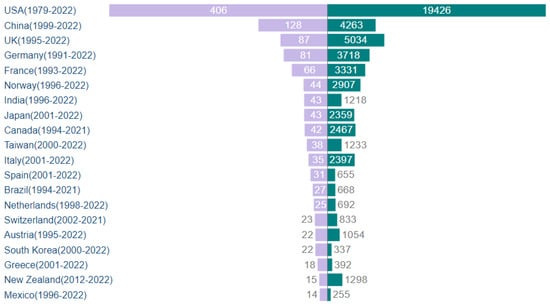
Figure 5.
Most productive countries in terms of total publications and citations (Purple bar shows number of publications and green shows number of citations).
Bibliometric analysis offers insights into the leading institutions in various countries regarding the subject. This analysis is beneficial for researchers, as it helps them identify potential hubs for specific research, training opportunities, workshops, and post-doctoral study tours. By examining the most productive institutions in various countries, scholars can establish connections and collaborations to further their research endeavours [27].
Figure 6 shows the top organizations and their impact on publishing research on this topic. Ten of the top 20 organizations are located in North America, including the top three. The other ten come from Asia and Europe, with five from each. North American organizations also have higher impacts than those from other continents. The top four organizations, in terms of publications, are NASA (National Aeronautics and Space Administration), USA, NOAA (National Oceanic and Atmospheric Administration), USA, University of Colorado, USA and China Academy of Sciences, China. It can be inferred that these organizations are actively involved in studying the sensitivity of ozone formation.
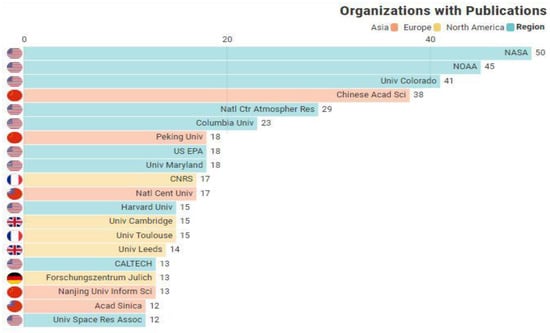
Figure 6.
Most productive organizations in ozone formation sensitivity research publications.
Figure S1 shows the top organizations in terms of citations in research regarding O3 formation sensitivity. Figure S2 shows collaborations among countries. The USA has the most collaborations and published research on the topic, collaborating with the highest number of countries. The UK is the second most collaborative country, followed by Germany, France, and China. The USA collaborates most with the UK, Germany, France, China, and Norway. The UK collaborates most with Germany, France, Norway, and Japan.
3.5. Frequently Used Author Keywords
Author keyword analysis generates information about the words that appear in the titles or abstracts of publications. This kind of analysis is crucial for exploring research topics, as authors use keywords to convey specific ideas [28]. Based on author keywords, we investigate the areas focused on and give a topical analysis with an emphasis on O3 formation regimes over the years. We investigate the shifts in the focus of authors dealing with the topic. Keywords with higher recurrence are chosen carefully to ascertain the key research scopes and related evolving dimensions [29,30].
Figure 7 shows the author keyword map, and Figure S3 shows the author keywords as a word cloud. The size of the circles in Figure 7 indicates the keyword search frequency use, with bigger circles implying more significant usage. Likewise, the word size in Figure S3 indicates the keyword use frequency. In both Figure 7 and Figure S3, the author keywords “ozone”, “ozone precursors”, “air quality”, “surface ozone”, “tropospheric ozone”, “nitrogen oxides”, climate change”, and “air pollution” appear most frequently. Figure S4 shows the evolution of author-supplied keywords in ozone research and the author-supplied keywords with the highest frequency in the corresponding year. The keyword flow between nodes shows the evolutionary direction, while the node size indicates keyword usage frequency. Themes that have no connection with the evolved themes are not shown.
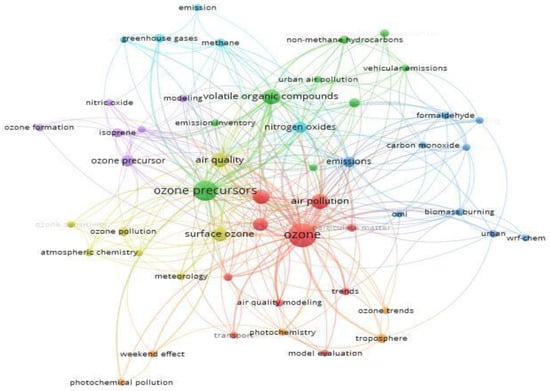
Figure 7.
Frequently used author keywords network visualization in ozone formation sensitivity research.
The keyword “ozone” remained the same from 1965 to 2000 but then evolved into new keywords, as shown in Figure S4. The keyword “biogenic emissions” evolved into “volatile organic compounds” and “ozone precursors”.
3.6. Highly Cited Documents
Citation analysis is an essential bibliometric feature that demonstrates the significance and prestige of a research paper within the scientific community. A highly impactful article (HIA) is an indicator of a high-quality publication. Wang and Ho [28] propose that researchers should prioritize recent HIAs, taking into account their citation count. Sillman S [11] is the most cited document in ozone formation regime research, published in the journal Atmospheric Environment. This article provides an overview of the research into the relationship between O3 and its primary precursors, volatile organic compounds and nitrogen oxides. The second most cited article is Wang et al. [31], published in the journal Science of the Total Environment. This study provides a review of studies on tropospheric O3 in China and insight into the impact of meteorological processes and precursors on ozone formation. The third most cited document is Chameides et al. [32], published in the Journal of Geophysical Research. This study analyses concentrations of O3, NOx and non-methane hydrocarbons to show the relationship between ozone and its precursors.
4. Implications and Limitations of This Study
The results of this study have vital implications for the scientific productivity surrounding the subject. The analyses pave the way toward a better understanding of how specific countries, institutions, authors and research hotspots contribute to ozone formation research. This study highlights the extensive work published over the years based on various metrics and illustrates the standing of various research institutions in terms of research output.
It is noteworthy that, except for China, Asian countries lag behind European countries in terms of research productivity. A detailed insight into current and prospective positions on the subject is provided, with an in-depth literature review of pioneering research articles and key research hotpots. A comprehensive analysis with detailed information on each parameter is conducted. A country’s scientific productivity is, for instance, not only an indicator of the quality of research but of the potential for future collaboration networks. The high impact of published research is suggestive of the vitality of the subject for its specific audience. An important implication of the current analysis is recognizing faltering deviations in the research dynamics, which is crucial for policymaking in this domain.
Our study reveals some significant and interesting findings; however, there are certain limitations. Firstly, it is difficult to extract full information from keyword analysis maps generated by the bibliometric technique. A more comprehensive investigation could expand the information content to include the titles, abstracts and main text, not relying merely on keywords. Furthermore, we show that the subject lacks quantitative studies, which should be more of a focus in the future. However, such studies require objective data, which is either lacking or difficult to obtain. There is still uncertainty in some data sources and about data collection tools’ ability to provide the desired datasets for analysis and research. Finally, this study only includes articles from the WOSCC search engine, which covers most articles, but some articles from other databases and search engines may be missing. Therefore, an analysis based on cross-comparison and multi-source searching would be more accurate and conclusive.
5. Conclusions
The current study uses a bibliometric technique to analyse the growth in the subject domain by finding recent trends and hotspots in O3 formation sensitivity research. In order to meet the objectives, we perform an analysis of 951 publications and visualize the prospects of these publications in terms of prominent countries, research categories, institutions, authors, and journals. This study is a crucial indicator of the importance and contribution of research institutions that employ different research metrics across the globe. In terms of research output, the USA and China emerge on top. The USA has the greatest impact, followed by the UK, Germany, France, and China. On a territory basis, Europe is the most productive continent, followed by North America and Asia. Based on the analysis of the thematic evolution using author-supplied keywords, it is observed that the terms “volatile organic compounds” and “ozone precursors” have recently gained prominence with an increased frequency. This indicates a growing trend in research focused on these topics in the future. This analysis is crucial, as it has a substantial tendency to monitor indeterminate variations in research inclinations reflected in the literature, which act as crucial keys to assist policymaking. Using recent citation trends, the articles with the highest impact are identified.
Supplementary Materials
The following supporting information can be downloaded at: https://www.mdpi.com/article/10.3390/pr11082240/s1, Figure S1: Most productive organizations in terms of citation regarding ozone formation sensitivity research; Figure S2. The collaborations network among the countries regarding ozone formation sensitivity research; Figure S3. The frequently used author keywords represented as word clouds; Figure S4. Thematic evolution of Author keywords in Ozone formation sensitivity research.
Author Contributions
Conceptualization, Z.J. and K.M.; methodology, Z.J. and K.M.; software, K.M.; validation, C.X., A.T. and Z.J.; formal analysis, K.M. and Z.J.; investigation, X.Z.; resources, Z.J., X.Z. and D.D.; data curation, A.T., M.A.K. and N.S.; writing—original draft preparation, Z.J.; writing—review and editing, C.L., X.Z. and D.D.; visualization, M.A.K. and N.S.; supervision, X.Z. and K.M.; project administration, Z.J. and X.Z.; funding acquisition, Z.J., X.Z. and D.D. All authors have read and agreed to the published version of the manuscript.
Funding
This study was supported by the Jiangsu Province funding program for Excellent Postdoctoral Talent (Grant No. 2022ZB651), the National Natural Science Foundation of China (Grant No. 32271587), the Carbon Peak and Carbon Neutrality Technology Innovation Foundation of Jiangsu Province (Grant No. BK20220030), the Scientific Research Foundation for Senior Talent of Jiangsu University, China (Grant No. 20JDG067), and the Jiangsu Province “Double Innovation PhD” Grant.
Institutional Review Board Statement
Not applicable.
Informed Consent Statement
Not applicable.
Data Availability Statement
The datasets used during the study are available from the corresponding author on request.
Conflicts of Interest
The authors declare no conflict of interest.
References
- Khaniabadi, Y.O.; Hopke, P.K.; Goudarzi, G.; Daryanoosh, S.M.; Jourvand, M.; Basiri, H. Cardiopulmonary mortality and COPD attributed to ambient ozone. Environ. Res. 2017, 152, 336–341. [Google Scholar] [CrossRef] [PubMed]
- Huang, J.; Li, G.; Xu, G.; Qian, X.; Zhao, Y.; Pan, X.; Huang, J.; Cen, Z.; Liu, Q.; He, T.; et al. The burden of ozone pollution on years of life lost from chronic obstructive pulmonary disease in a city of Yangtze River Delta, China. Environ. Pollut. 2018, 242, 1266–1273. [Google Scholar] [CrossRef] [PubMed]
- Yu, S.; Yin, S.; Zhang, R.; Wang, L.; Su, F.; Zhang, Y.; Yang, J. Spatiotemporal characterization and regional contributions of O3 and NO2: An investigation of two years of monitoring data in Henan, China. J. Environ. Sci. 2020, 90, 29–40. [Google Scholar] [CrossRef] [PubMed]
- Belis, C.A.; Van Dingenen, R.; Klimont, Z.; Dentener, F. Scenario analysis of PM2.5 and ozone impacts on health, crops and climate with TM5-FASST: A case study in the Western Balkans. J. Environ. Manag. 2022, 319, 115738. [Google Scholar] [CrossRef]
- Juráň, S.; Grace, J.; Urban, O. Temporal Changes in Ozone Concentrations and Their Impact on Vegetation. Atmosphere 2021, 12, 82. [Google Scholar] [CrossRef]
- Chaudhary, I.J.; Rathore, D. Relative effectiveness of ethylenediurea, phenyl urea, ascorbic acid and urea in preventing groundnut (Arachis hypogaea L.) crop from ground level ozone. Environ. Technol. Innov. 2020, 19, 100963. [Google Scholar] [CrossRef]
- Haagen-Smit, A.J. Chemistry and physiology of Los Angeles smog. Ind. Eng. Chem. 1952, 44, 1342–1346. [Google Scholar] [CrossRef]
- Ma, M.; Yao, G.; Guo, J.; Bai, K. Distinct spatiotemporal variation patterns of surface ozone in China due to diverse influential factors. J. Environ. Manag. 2021, 288, 112368. [Google Scholar] [CrossRef]
- Sun, J.; Shen, Z.; Wang, R.; Li, G.; Zhang, Y.; Zhang, B.; He, K.; Tang, Z.; Xu, H.; Qu, L.; et al. A comprehensive study on ozone pollution in a megacity in North China Plain during summertime: Observations, source attributions and ozone sensitivity. Environ. Int. 2021, 146, 106279. [Google Scholar] [CrossRef]
- Du, Y.; Zhao, K.; Yuan, Z.; Luo, H.; Ma, W.; Liu, X.; Wang, L.; Liao, C.; Zhang, Y. Identification of close relationship between large-scale circulation patterns and ozone-precursor sensitivity in the Pearl River Delta, China. J. Environ. Manag. 2022, 312, 114915. [Google Scholar] [CrossRef]
- Sillman, S. The relation between ozone, NOx and hydrocarbons in urban and polluted rural environments. Atmos. Environ. 1999, 33, 1821–1845. [Google Scholar] [CrossRef]
- Lu, H.; Lyu, X.; Cheng, H.; Ling, Z.; Guo, H. Overview on the spatial–temporal characteristics of the ozone formation regime in China. Environ. Sci. Process. Impacts 2019, 21, 916–929. [Google Scholar] [CrossRef] [PubMed]
- Zhang, K.; Xu, J.; Huang, Q.; Zhou, L.; Fu, Q.; Duan, Y.; Xiu, G. Precursors and potential sources of ground-level ozone in suburban Shanghai. Front. Environ. Sci. Eng. 2020, 14, 92. [Google Scholar] [CrossRef]
- Javed, Z.; Wang, Y.; Xie, M.; Tanvir, A.; Rehman, A.; Ji, X.; Xing, C.; Shakoor, A.; Liu, C. Investigating the impacts of the COVID-19 lockdown on trace gases using ground-based MAX-DOAS observations in Nanjing, China. Remote Sens. 2020, 12, 3939. [Google Scholar] [CrossRef]
- Tanvir, A.; Javed, Z.; Jian, Z.; Zhang, S.; Bilal, M.; Xue, R.; Wang, S.; Bin, Z. Ground-based MAX-DOAS observations of tropospheric NO2 and HCHO during COVID-19 lockdown and spring festival over Shanghai, China. Remote Sens. 2021, 13, 488. [Google Scholar] [CrossRef]
- Javed, Z.; Bilal, M.; Qiu, Z.; Li, G.; Sandhu, O.; Mehmood, K.; Wang, Y.; Ali, M.A.; Liu, C.; Wang, Y.; et al. Spatiotemporal characterization of aerosols and trace gases over the Yangtze River Delta region, China: Impact of trans-boundary pollution and meteorology. Environ. Sci. Eur. 2022, 34, 86. [Google Scholar] [CrossRef] [PubMed]
- Kroll, J.H.; Heald, C.L.; Cappa, C.D.; Farmer, D.K.; Fry, J.L.; Murphy, J.G.; Steiner, A.L. The complex chemical effects of COVID-19 shutdowns on air quality. Nat. Chem. 2020, 12, 777–779. [Google Scholar] [CrossRef]
- Duncan, B.N.; Yoshida, Y.; Olson, J.R.; Sillman, S.; Martin, R.V.; Lamsal, L.; Hu, Y.; Pickering, K.E.; Retscher, C.; Allen, D.J.; et al. Application of OMI observations to a space-based indicator of NOx and VOC controls on surface ozone formation. Atmos. Environ. 2010, 44, 2213–2223. [Google Scholar] [CrossRef]
- Hong, Q.; Zhu, L.; Xing, C.; Hu, Q.; Lin, H.; Zhang, C.; Zhao, C.; Liu, T.; Su, W.; Liu, C. Inferring vertical variability and diurnal evolution of O3 formation sensitivity based on the vertical distribution of summertime HCHO and NO2 in Guangzhou, China. Sci. Total Environ. 2022, 827, 154045. [Google Scholar] [CrossRef]
- Dai, H.; Zhu, J.; Liao, H.; Li, J.; Liang, M.; Yang, Y.; Yue, X. Co-occurrence of ozone and PM2.5 pollution in the Yangtze River Delta over 2013–2019: Spatiotemporal distribution and meteorological conditions. Atmos. Res. 2021, 249, 105363. [Google Scholar] [CrossRef]
- Xue, J.; Zhao, T.; Luo, Y.; Miao, C.; Su, P.; Liu, F.; Zhang, G.; Qin, S.; Song, Y.; Bu, N.; et al. Identification of ozone sensitivity for NO2 and secondary HCHO based on MAX-DOAS measurements in northeast China. Environ. Int. 2022, 160, 107048. [Google Scholar] [CrossRef] [PubMed]
- Mehmood, K.; Bao, Y.; Saifullah Cheng, W.; Khan, M.A.; Siddique, N.; Abrar, M.M.; Soban, A.; Fahad, S.; Naidu, R. Predicting the quality of air with machine learning approaches: Current research priorities and future perspectives. J. Clean. Prod. 2022, 379, 134656. [Google Scholar] [CrossRef]
- Ye, N.; Kueh, T.B.; Hou, L.; Liu, Y.; Yu, H. A bibliometric analysis of corporate social responsibility in sustainable development. J. Clean. Prod. 2020, 272, 122679. [Google Scholar] [CrossRef]
- Wong, S.; Nyakuma, B.; Wong, Y.; Lee, T.; Lee, H.; Lee, H. Microplastics and nanoplastics in global food webs: A bibliometric analysis (2009–2019). Mar. Pollut. Bull. 2020, 158, 111432. [Google Scholar] [CrossRef] [PubMed]
- Chiu, W.-T.; Ho, Y.-S. Bibliometric analysis of tsunami research. Scientometrics 2007, 73, 3–17. [Google Scholar] [CrossRef]
- Usman, M.; Ho, Y.-S. A bibliometric study of the Fenton oxidation for soil and water remediation. J. Environ. Manag. 2020, 270, 110886. [Google Scholar] [CrossRef]
- Vanzetto, G.V.; Thomé, A. Bibliometric study of the toxicology of nanoescale zero valent iron used in soil remediation. Environ. Pollut. 2019, 252, 74–83. [Google Scholar] [CrossRef]
- Wang, C.-C.; Ho, Y.-S. Research trend of metal–organic frameworks: A bibliometric analysis. Scientometrics 2016, 109, 481–513. [Google Scholar] [CrossRef]
- Hamidi, A.; Ramavandi, B. Evaluation and scientometric analysis of researches on air pollution in developing countries from 1952 to 2018. Air Qual. Atmos. Health 2020, 13, 797–806. [Google Scholar] [CrossRef]
- Mao, G.; Hu, H.; Liu, X.; Crittenden, J.; Huang, N. A bibliometric analysis of industrial wastewater treatments from 1998 to 2019. Environ. Pollut. 2021, 275, 115785. [Google Scholar] [CrossRef]
- Wang, T.; Xue, L.; Brimblecombe, P.; Lam, Y.F.; Li, L.; Zhang, L. Ozone pollution in China: A review of concentrations, meteorological influences, chemical precursors, and effects. Sci. Total Environ. 2017, 575, 1582–1596. [Google Scholar] [CrossRef] [PubMed]
- Chameides, W.L.; Fehsenfeld, F.; Rodgers, M.O.; Cardelino, C.; Martinez, J.; Parrish, D.; Lonneman, W.; Lawson, D.R.; Rasmussen, R.A.; Zimmerman, P.; et al. Ozone precursor relationships in the ambient atmosphere. J. Geophys. Res. Atmos. 1992, 97, 6037–6055. [Google Scholar] [CrossRef]
Disclaimer/Publisher’s Note: The statements, opinions and data contained in all publications are solely those of the individual author(s) and contributor(s) and not of MDPI and/or the editor(s). MDPI and/or the editor(s) disclaim responsibility for any injury to people or property resulting from any ideas, methods, instructions or products referred to in the content. |
© 2023 by the authors. Licensee MDPI, Basel, Switzerland. This article is an open access article distributed under the terms and conditions of the Creative Commons Attribution (CC BY) license (https://creativecommons.org/licenses/by/4.0/).